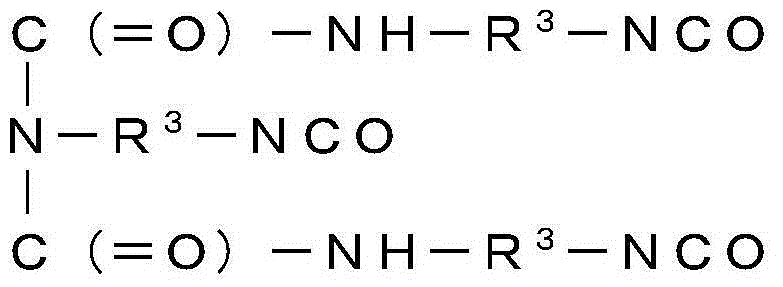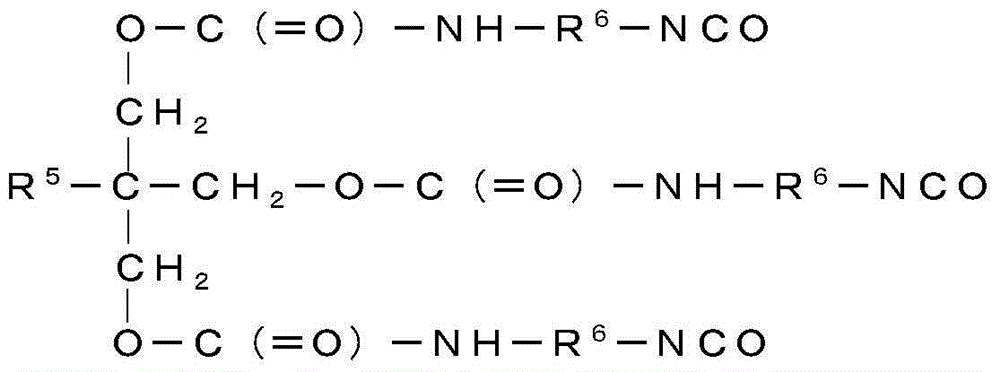Undercoat used for base material with copper film, base material with copper film, manufacturing method for base material with copper film, and conductive film
A technology of copper thin film and primer, applied in the field of conductive film, can solve the problems of copper vapor deposition layer peeling, nickel lack of alkali resistance and acid resistance, falling off, etc., and achieve good alkali resistance and acid resistance adhesion, Excellent adhesion and scratch resistance
- Summary
- Abstract
- Description
- Claims
- Application Information
AI Technical Summary
Problems solved by technology
Method used
Image
Examples
Embodiment
[0102] Next, the present invention will be described in further detail by way of examples and comparative examples, however, the scope of the present invention is not limited by these examples. In addition, "part" in an Example shows a weight standard. In addition, the hydroxyl value is a value measured in accordance with JIS-0070. In addition, the glass transition temperature is a value measured using a commercially available measuring instrument (product name "DSC8230B", manufactured by Rigaku Electric Co., Ltd.).
[0103]
manufacture example 1
[0105] Into a reaction vessel having a stirrer, a thermometer, a reflux condenser, a dropping funnel, and a nitrogen introduction tube, 40.8 parts (13.6 mol %) of hydroxyethyl acrylate (HEA) as the component (a1) and 40.8 parts (13.6 mol %) as the component (a2) were mixed. 72.0 parts (about 27.7 mol%) of methyl methacrylate (MMA), 79.2 parts (about 23.8 mol%) of butyl acrylate (BA), 48.0 parts (34.9 mol%) of acrylonitrile (AN) as (a3) component ) and 445.7 parts of ethyl acetate as the (G) component, and the reaction system was set at 70°C. Next, 1.2 parts of 2,2'-azobis(2,4-dimethylvaleronitrile) (ABN-V) was mixed in, and it heat-retained at around 70 degreeC for 6 hours. Next, 2.4 parts of ABN-V was mixed in, and the reaction system was kept at the same temperature for another 6 hours. Thereafter, the reaction system was cooled to room temperature to obtain a solution of an acrylic acid copolymer (A-1) having a glass transition temperature of 13° C. and a hydroxyl value ...
manufacture example 2
[0107] In the same reaction vessel as in Production Example 1, 51.0 parts (13.3 mol %) of HEA as (a1) component, 72.0 parts (about 21.8 mol %) of MMA as (a2) component and 102.0 parts of BA ( About 24.1 mol %), 60.0 parts (about 34.3 mol %) of AN as (a3) component, 15.0 parts (about 6.4 mol %) of acrylamide (AM) as (a4) component, and (G) component 557.1 parts of ethyl acetate, and the reaction system was set at 70°C. Next, 1.5 parts of ABN-V was mixed and kept at around 70°C for 6 hours. Next, 3.0 parts of ABN-V was mixed in, and the reaction system was further incubated at around the same temperature for 6 hours. Thereafter, the reaction system was cooled to room temperature to obtain a solution of an acrylic copolymer (A-2) having a glass transition temperature of 13° C. and a hydroxyl value of 80 mgKOH / g.
PUM
| Property | Measurement | Unit |
|---|---|---|
| Glass transition temperature | aaaaa | aaaaa |
| Hydroxyl value | aaaaa | aaaaa |
| Glass transition temperature | aaaaa | aaaaa |
Abstract
Description
Claims
Application Information
 Login to View More
Login to View More - R&D
- Intellectual Property
- Life Sciences
- Materials
- Tech Scout
- Unparalleled Data Quality
- Higher Quality Content
- 60% Fewer Hallucinations
Browse by: Latest US Patents, China's latest patents, Technical Efficacy Thesaurus, Application Domain, Technology Topic, Popular Technical Reports.
© 2025 PatSnap. All rights reserved.Legal|Privacy policy|Modern Slavery Act Transparency Statement|Sitemap|About US| Contact US: help@patsnap.com



